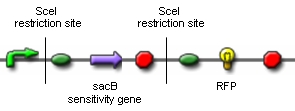Team:ETH Zurich/Wetlab/Overview
From 2008.igem.org
| Line 41: | Line 41: | ||
| valign="top" align="center" width="450"| | | valign="top" align="center" width="450"| | ||
'''1)''' [[Team:ETH_Zurich/Wetlab/Genome_Reduction|'''Genome Reduction''']] | '''1)''' [[Team:ETH_Zurich/Wetlab/Genome_Reduction|'''Genome Reduction''']] | ||
| + | |||
[[Image:proof_of_concept_construct,_symbols.jpg|center|300px|]] | [[Image:proof_of_concept_construct,_symbols.jpg|center|300px|]] | ||
| + | |||
<div style="text-align:justify;"> | <div style="text-align:justify;"> | ||
'''Questions:'''<br> | '''Questions:'''<br> | ||
| Line 51: | Line 53: | ||
<br><br> | <br><br> | ||
'''Results:''' <br> | '''Results:''' <br> | ||
| - | + | We cloned promoters. During our attempts to design the construct coding for RFP flanked by SceI restriction sites, we managed to insert one SceI restriction site in front of the RFP by annealing oligonucleotide duplexes.<br><br> | |
</div> | </div> | ||
| valign="top" align="center" width="450"| | | valign="top" align="center" width="450"| | ||
Revision as of 00:14, 30 October 2008
|
OverviewIn order to approach our goal of creating an E. coli strain carrying a minimal genome, there are three main problems that have to be overcome:
Chemostat selection: introduce a limitation that confers a growth advantage to organisms with smaller genomes Switch circuit: design a biobrick that provides for short-term synthesis of the desired gene products
1. Genome ReductionTo prove that in vivo restriction and religation is possible is fundamental to our project which relies on short-term expression of a restriction enzyme and a ligase. While the restriction enzyme will randomly cut DNA, the simultaneous or shortly delayed synthesis of the ligase should religate the DNA. If the DNA is cut at several sites, religation will lead to exclusion of chromosomal fragments in a random manner. 2. Chemostat selectionIn the continuous culture of a chemostat, those organisms with the highest rate of proliferation will overgrow those with a smaller growth rate. In order to bypass the need of selecting for those E. coli which have successfully reduced their genomes by massive screening of thousands of clones, we need to introduce a constraint that confers a growth advantage to organisms with smaller genomes. We have chosen to introduce mutations in the nucleotide synthesis pathway to achieve this goal. This will render DNA replication the rate-limiting step of proliferation and therefore be advantageous to organisms with small genomes. 3. Switch circuitExpression of restriction enzymes that cut genomic DNA inside the cell is likely to decrease viability. Actually, the Waterloo iGEM team is using restriction enzymes to kill the cell in their project this year. Therefore, construction of a switch circuit, which allows to restrict expression of the restriction enzyme to a short period of time, is a crucial part of the project.
|
 "
"
